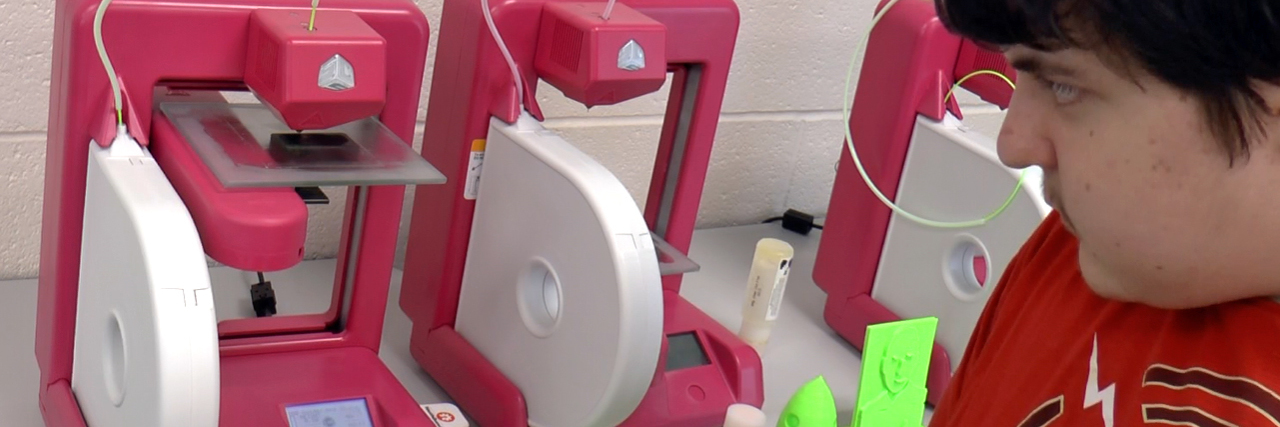When the YouthQuest Foundation, the nonprofit organization where I work, started a 3D printing program years ago, we had no idea how much it could help young people on the autism spectrum.
It’s been gratifying to watch the progress of the students we’ve reached through our partnership with the PHILLIPS Programs for Children and Families in Northern Virginia. One of them is Henry, who graduated in June from the PHILLIPS School in Annandale. Recently, he was part of a cross-country collaboration showing how our program develops skills that help teens with autism spectrum disorder become independent, successful adults.
YouthQuest’s 3D ThinkLink Initiative uses 3D printing as a vehicle to teach vocational skills along with life lessons about solving problems, learning from mistakes and persevering to achieve goals.
Creating 3D objects is an exercise in trial and error that changes our students’ perception of failure. They come to see it as part of the learning process and a step toward eventual success. The most important lesson they learn is that in 3D printing and in life, failure is not final.
When YouthQuest’s Director of Instruction Tom Meeks discovered the Fort Vancouver Virtual Reality project, he saw a learning opportunity for our PHILLIPS students as well as the kids at iTech Preparatory, a STEM-focused magnet school in Vancouver, Washington.
Award-winning teacher John Zingale’s seventh and eighth graders did 3D scanning of 19th-century artifacts from the Fort Vancouver National Historic Site to create an interactive virtual museum. What they lacked was a way to make realistic replicas of the scanned artifacts that could be handled and studied without fear of damaging the originals.
Tom contacted “Mr. Z” and offered to have our students use the full-color powder/binder printer in YouthQuest’s lab to make the reproductions. It was a great way to demonstrate our concept for giving high school graduates on the autism spectrum a path to employment. This is vitally important to us because nearly half of young adults with autism are unemployed and not enrolled in higher education two years after high school.
Henry was a natural choice for the project. He was in our first 3D ThinkLink class at PHILLIPS in 2016 and attended a week of advanced training in our lab, where get got hands-on experience with the powder printer, a professional machine that’s very different from the simple 3D printers at his school that melt plastic filament to make single-color objects. Henry continued developing his skills in the 3D printing club on the Annandale campus during the last two years.
Two 3D students from the PHILLIPS Fairfax campus, John and Ladrious, rounded out the team. Over the course of three days in June, they mastered every step of the process: taking in the 3D image files; preparing the files in the printing software; setting up and operating the printer; post-processing the printed objects; and packaging them for shipping to Vancouver.
Mr. Z and his students were delighted with the results and they want to continue our partnership when the new school year begins.
YouthQuest created the 3D ThinkLink curriculum to introduce students to CAD (computer-aided design) and 3D printer operation. At PHILLIPS, we provided the hardware and software, and trained the teachers, who then tailored the lessons for their ASD students.
We’ve found that common characteristics of people on the autism spectrum — attention to detail, deep focus, visual learning, tenacity, outside-the-box thinking — help them excel at 3D design and printing.
“These are students that have failed often in the classroom and they don’t always have the confidence that they can learn and be successful. The 3D class really gives them that,” said Lindsay Harris, director of the PHILLIPS Career Partners Program.
For the past three years, Lindsay told me, Henry has said he wants people to think of him as “a tech guru.” At first he appeared to be far from that goal. Lindsay recalled that he was tuned out at school, not making friends and spending a lot of time with his head down on his desk. By the time I met him, he was part of the 3D class and things had changed. As Lindsay put it, “the ignition switch for his internal drive was turned on.”
Henry’s progress was not without its moments of drama. His first 3D design was missing a major component. He felt embarrassed thinking it showed his lack of skills, and ran out of class. Lindsay said it took several hours to coax him out from hiding under a desk. Over time, Henry took our “failure is not final” motto to heart and now he laughs when he tells people about that first failed project.
As Henry’s competence in technology grew, so did his self-confidence. When Lindsay visited the lab, she was amazed to see how easily the boys were socializing and communicating as they collaborated to accomplish their tasks, even though Henry had not met John and Ladrious before this project.
With the “hard” tech skills, “soft” interpersonal skills and confidence-building experience of working through failure to achieve success that our program provides, Henry is on his way to making his tech guru dream a reality.

